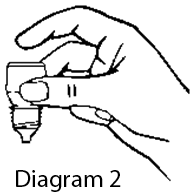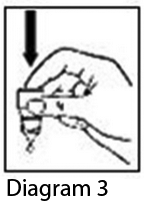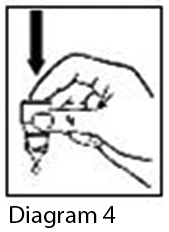SUMMARY CMI
Travatan®
Consumer Medicine Information (CMI) summary
The full CMI on the next page has more details. If you are worried about using this medicine, speak to your doctor or pharmacist.
1. Why am I using Travatan?
Travatan contains the active ingredient Travoprost. Travatan is used to treat certain eye conditions such as high pressure inside your eye and open angle glaucoma (an eye condition caused by fluid buildup that damages the optic nerve).
For more information, see Section 1. Why am I using Travatan? in the full CMI.
2. What should I know before I use Travatan?
Do not use if you have ever had an allergic reaction to Travatan or any of the ingredients listed at the end of the CMI.
Talk to your doctor if you have any other medical conditions, take any other medicines, or are pregnant or plan to become pregnant or are breastfeeding.
For more information, see Section 2. What should I know before I use Travatan? in the full CMI.
3. What if I am taking other medicines?
Some medicines may interfere with Travatan and affect how it works.
A list of these medicines is in Section 3. What if I am taking other medicines? in the full CMI.
4. How do I use Travatan?
- Put one drop of Travatan into the affected eye(s) each day.
- Follow the instructions provided and use Travatan until your doctor tells you to stop.
More instructions can be found in Section 4. How do I use Travatan? in the full CMI.
5. What should I know while using Travatan?
| Things you should do |
|
| Things you should not do |
|
| Driving or using machines |
|
| Looking after your medicine |
|
For more information, see Section 5. What should I know while using Travatan? in the full CMI.
6. Are there any side effects?
Common side effects include itchy eyes, redness of the eye(s), eye pain, eye discharge, eye irritation, feeling that something is in your eye(s), reduced vision, headache.
For more information, including what to do if you have any side effects, see Section 6. Are there any side effects? in the full CMI.
FULL CMI
Travatan® 0.004% Eye Drops Solution
Active ingredient: Travoprost
Consumer Medicine Information (CMI)
This leaflet provides important information about using Travatan. You should also speak to your doctor or pharmacist if you would like further information or if you have any concerns or questions about using Travatan.
Where to find information in this leaflet:
1. Why am I using Travatan?
2. What should I know before I use Travatan?
3. What if I am taking other medicines?
4. How do I use Travatan?
5. What should I know while using Travatan?
6. Are there any side effects?
7. Product details
1. Why am I using Travatan?
Travatan contains the active ingredient Travoprost. It belongs to a class of drugs called Prostaglandin analogs.
Travatan is used to treat certain types of eye conditions such as high pressure inside your eye and open angle glaucoma (an eye condition caused by fluid buildup that damages the optic nerve).
Travatan helps to lower the increased eye pressure by increasing the amount of fluid that drains from the eye. It is used either alone or in combination with other medicines or eye drops.
2. What should I know before I use Travatan?
Warnings
Do not use Travatan:
- If you are allergic to Travoprost, or any of the ingredients listed at the end of this leaflet. Always check the ingredients to make sure you can use this medicine. Symptoms of an allergic reaction may include shortness of breath, difficulty breathing, swelling of the face, lips, tongue or other parts of the body, rash, hives.
- If you are pregnant or planning to become pregnant.
Check with your doctor if you:
- have any medical conditions such as any problems with your eye lens or narrow angle glaucoma (an eye condition that occurs when the structure inside the eye which allows the fluid to drain normally becomes restricted).
- take any medicines for any condition.
- suffer from any swelling of the eye or any diseases of the cornea.
During treatment, you may be at risk of developing certain side effects. It is important you understand these risks and how to monitor for them. See additional information under Section 6. Are there any side effects?
Pregnancy and breastfeeding
Check with your doctor if you are pregnant or intend to become pregnant.
Travatan should not be used in pregnancy or in women planning to become pregnant.
Talk to your doctor if you are breastfeeding or intend to breastfeed.
Travatan is not recommended to be used while breastfeeding.
3. What if I am taking other medicines?
Tell your doctor or pharmacist if you are taking any other medicines, including any medicines, vitamins or supplements that you buy without a prescription from your pharmacy, supermarket or health food shop.
Some medicines may interfere with Travatan and affect how it works.
Check with your doctor if you take any medicines to treat glaucoma or any other medicines or eye drops.
Check with your doctor or pharmacist if you are not sure about what medicines, vitamins or supplements you are taking and if these affect Travatan.
4. How do I use Travatan?
How much to use
- Put one drop of Travatan into the affected eye(s) each day.
- Follow the instructions provided and use Travatan until your doctor tells you to stop.
- If you are using any other eye drops, use the eye drops at least 5 minutes apart.
- Tell your doctor or pharmacist if you do not understand your dose.
When to use Travatan
- Travatan should be used at the same time each day, unless your doctor tells you otherwise.
- Maximum effect is obtained if the dose is used in the evening.
How to use Travatan
- Sitting or lying down position might make the process simpler.
- Remove contact lenses if you are wearing them before putting in the eye drops.
- Shake the bottle well prior to use.
Follow the steps below to use Travatan:
- Wash your hands thoroughly with soap and water.
- Before using a bottle for the first time, tear off the overwrap pouch and take the bottle out (refer diagram 1).

- Remove the cap from the bottle.
- Mix the contents of the bottle by inverting 5 to 10 times.
- Hold the bottle upside down in one hand between your thumb and middle finger (refer diagram 2).

- Tilt your head back, gently pull down the lower eyelid of your eye to form a pouch/pocket.
- Place the tip of the bottle close to your eye. Do not touch the tip to your eye as this may cause injury to the eye.
- Do not touch the dropper tip to eyelid or surrounding areas or any surface to avoid contamination of the dropper tip and solution.
- Release one drop into the pouch/pocket formed between your eye and eyelid by gently tapping or pressing the base of the bottle with your forefinger (refer diagrams 3 and 4).


- Gently close your eye. Do not blink or rub your eye.
- When your eye is closed, place your index finger against the inside corner of your eye and press against your nose for about two minutes. This may result in less side effects by preventing the medicine from draining through the tear duct to the nose and throat, from where it can be absorbed into other parts of your body.
- This will also help to prevent the unpleasant taste sensation that some people experience while using these eye drops.
- If necessary, repeat the above steps for the other eye.
- You may feel a slight burning sensation in the eye shortly after using Travatan. If it continues, or is uncomfortable, contact your doctor or pharmacist.
- If you want to use any other eye drops wait at least 5 minutes after putting Travatan in.
- It is normal for a small amount of the eye drops to spill onto your cheek since your eyelids can only hold less than one drop at a time. Wipe away any spillage with a tissue.
- Replace the cap on the bottle and close it tightly.
- Always keep the bottle tightly closed when not in use.
- Wash your hands again with soap and water to remove any residue.
- Discard the Travatan 4 weeks after opening it.
If you forget to use Travatan
Travatan should be used regularly at the same time each day. If you miss your dose at the usual time, put the drops in as soon as you remember and then go back to using them as recommended by your doctor.
If it is almost time for your next dose, skip the dose you missed and take your next dose when you are meant to.
Do not take a double dose to make up for the dose you missed.
If you use too much Travatan
If you think that you have used too much Travatan, you may need urgent medical attention.
You should immediately:
- phone the Poisons Information Centre
(by calling 13 11 26), or - contact your doctor, or
- go to the Emergency Department at your nearest hospital.
You should do this even if there are no signs of discomfort or poisoning.
If you accidentally put several Travatan drops into your eyes, immediately wash your eyes with warm tap water.
5. What should I know while using Travatan?
Things you should do
Use Travatan only for Eye use.
Remove the soft contact lenses before using Travatan. Put your lenses back in 15 minutes after putting the eye drops in.
Call your doctor straight away if you:
- notice any change in your eye colour.
- have any changes in your eyelashes such as increased length, thickness, pigmentation, and/or number of lashes or unwanted hollows of the upper eyelid, eyelid skin darkening after starting the treatment with Travatan.
- develop any signs of allergic reaction.
- become pregnant, are planning to become pregnant or if you are breast feeding while using Travatan.
Remind any doctor, dentist, pharmacist or specialist you visit that you are using Travatan.
Things you should not do
- Do not stop using this medicine suddenly.
- Do not use Travatan in children.
- Do not give Travatan to anyone else, even if they seem to have the same condition as you.
Driving or using machines
Be careful before you drive or use any machines or tools until you know how Travatan affects you.
Travatan may cause temporary blurred vision in some people after putting the eye drops in..
If so then, wait until your vision clears before driving or using machinery.
Looking after your medicine
- Store below 30°C
Follow the instructions in the carton on how to take care of your medicine properly.
Store it in a cool dry place away from moisture, heat or sunlight; for example, do not store it:
- in the bathroom or near a sink, or
- in the car or on window sills.
Keep it where young children cannot reach it.
When to discard your medicine
Discard Travatan 4 weeks after opening it.
Getting rid of any unwanted medicine
If you no longer need to use this medicine or it is out of date, take it to any pharmacy for safe disposal.
Do not use this medicine after the expiry date.
6. Are there any side effects?
All medicines can have side effects. If you do experience any side effects, most of them are minor and temporary. However, some side effects may need medical attention.
See the information below and, if you need to, ask your doctor or pharmacist if you have any further questions about side effects.
Less serious side effects
| Less serious side effects | What to do |
Eye problems:
| Speak to your doctor if you have any of these less serious side effects and they worry you. |
Serious side effects
| Serious side effects | What to do |
Eye problems
| Call your doctor straight away, or go straight to the Emergency Department at your nearest hospital if you notice any of these serious side effects. |
Tell your doctor or pharmacist if you notice anything else that may be making you feel unwell.
Other side effects not listed here may occur in some people.
Reporting side effects
After you have received medical advice for any side effects you experience, you can report side effects to the Therapeutic Goods Administration online at www.tga.gov.au/reporting-problems. By reporting side effects, you can help provide more information on the safety of this medicine.
Always make sure you speak to your doctor or pharmacist before you decide to stop taking any of your medicines.
7. Product details
This medicine is only available with a doctor's prescription.
What Travatan contain
| Active ingredient (main ingredient) | Travoprost. |
| Other ingredients (inactive ingredients) | Ethoxylated hydrogenated castor oil, boric acid, mannitol sodium chloride, propylene glycol, sodium hydroxide and/or hydrochloric acid (to adjust pH) polyquaternium-1 (preservative) and purified water. |
| Potential allergens | NA |
Do not take this medicine if you are allergic to any of these ingredients.
What Travatan looks like
Travatan is a clear, colourless, sterile and preserved solution that comes in LDPE or PP bottle.
Pack sizes: 1 x 2.5 mL and 3 X 2.5 mL.
Not all pack sizes or container types may be marketed.
Who distributes Travatan
Travatan is supplied in Australia by:
Novartis Pharmaceuticals Australia Pty Limited
ABN 18 004 244 160
54 Waterloo Road
Macquarie Park NSW 2113
Telephone No. 1800 671 203
www.novartis.com.au
Travatan is supplied in New Zealand by:
Novartis New Zealand Limited
PO Box 99102
Newmarket
Auckland 1149
New Zealand
Free Phone: 0800 354 335.
Australian Registration Number
AUST R: 173354
This leaflet was prepared in June 2025.
Internal document code
(tra071123c_v2) based on PI (tra071123i)
Published by MIMS August 2025



 Additional adverse reactions identified from postmarketing surveillance include the following (see Table 4). Frequencies cannot be estimated from the available data. Within each system organ class adverse reactions are presented in order of decreasing seriousness.
Additional adverse reactions identified from postmarketing surveillance include the following (see Table 4). Frequencies cannot be estimated from the available data. Within each system organ class adverse reactions are presented in order of decreasing seriousness.
 These studies conclusively demonstrate that monotherapy with travoprost 0.004% eye drops produce clinically relevant and statistically significant reductions in intraocular pressure; these reductions in pressure are maintained over a 12 month dosing period.
These studies conclusively demonstrate that monotherapy with travoprost 0.004% eye drops produce clinically relevant and statistically significant reductions in intraocular pressure; these reductions in pressure are maintained over a 12 month dosing period. This study conclusively demonstrates that travoprost 0.004% eye drops produce clinically relevant and statistically significant intraocular pressure reductions, compared to placebo, when used adjunctively with timolol eye drops 0.5%.
This study conclusively demonstrates that travoprost 0.004% eye drops produce clinically relevant and statistically significant intraocular pressure reductions, compared to placebo, when used adjunctively with timolol eye drops 0.5%. Chemical name: (5Z,13E)-(9S,11R,15R)-9,11,15-Trihydroxy-16-(m-trifluoromethylphenoxy)-17,18,19,20-tetranor-5,13-prostadienoic acid, isopropyl ester.
Chemical name: (5Z,13E)-(9S,11R,15R)-9,11,15-Trihydroxy-16-(m-trifluoromethylphenoxy)-17,18,19,20-tetranor-5,13-prostadienoic acid, isopropyl ester.